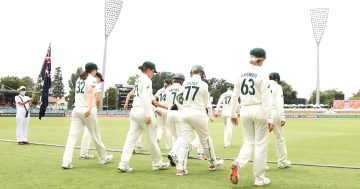
Victorious Test captain Pat Cummins and his teammates after the Sydney Test. Photo: Pat Cummins Facebook.
It’s always a melancholy time when the Sydney Test rolls around to conclude the international cricket season these days, compacted as it is to fit in the ephemeral and meaningless hit and giggle of the lamentably named Big Bash.
The so-called Pink Test, as opposed to the earlier Pink Ball Test, marks a premature end to summer and also, this year, my return to the office after a well-earned (if short seasonal) break.
It is unfashionable to rage against the shortened Test calendar and lack of first-class preparation for both touring and home sides. National teams rush from one tournament or series to another these days without the major stars playing much four-day cricket.
Perhaps that’s why, at varying times throughout the series, both Australian and Indian batsmen fell like ninepins to admittedly fine bowling. Three out of the five Tests ended on the third day and only one – the gripping Melbourne encounter – went down to the wire.
Rain washed the Brisbane Test away when Australia had the upper hand but there is a reason you play the Gabba first, not closer to Christmas.
Most of the commentary hailed the series a success – from the home side’s perspective, as well as the bumper crowds and the intense rivalry on the field.
And yes, there were moments of high drama, and an Australian victory, particularly over the now heavyweight Test nation of India, is always good to savour.
But there was much about the series that reflected what is not quite right about the modern game.
So much of our lives these days are hastened, frenetic and busied. Time is a commodity in demand and lacking in generosity.
Cricket was a game invented for lazy summer days when the demands of life can be on hold and we can yield to the rhythms of the season.
But this was a series in a rush to be over.
Helping this along were pitches laden with landmines and never destined to have to age into the dusty strips that provide a totality of experience for player and fan alike.
Australia’s premium spinner Nathan Lyon hardly worked up a sweat and that tantalising contest between bat and the rotating, arcing ball was regretfully missing.
Only the Melbourne pitch could be called a Test wicket – and we got five full days of great cricket, and Lyon delivered the final blow.
The quality of the fast bowling was undoubted – especially India’s Jasprit Bumrah and Australia’s Pat Cummins, and the now legendary Scott Boland. But overall, it was all a bit one-dimensional.
Oh, but wasn’t it exciting seeing all those wickets tumble?
Yes, but that begs questions about a lack of preparation and technique. And I will continue to point the finger at the white ball version and the devaluing of the Sheffield Shield competition.
There are admirable aspects of the modern game – the sparkling run rates, the sharper fielding and the players’ commitment to fitness. It is better than some of the stodgy stuff served up, mainly by English sides, in decades past.
However, the push to entertain despite the circumstances, the stuttering attention spans, and the inability of some players to exercise the patience to dig themselves and their sides out of a predicament are the downsides.
The public is also so ravenous for the next big thing that a youngster like Sam Konstas is hailed as a superstar for a streaky, improvised half-century that only a heady mix of youthful, cavalier fearlessness and arrogance can deliver.
Not only does it place unnecessary pressure on someone who has only played a handful of first-class games but it sets him – and us – up for massive disappointment if he falters and is discarded.
Let’s wait and see what he can do over time and in all conditions before declaring him a wunderkind.
For many, the vindication in this sugar hit of a series is the record crowds, which are seen as a vote of confidence in Test cricket. But what would those crowds have been if all Tests had been able to go the distance like the one in Melbourne?
Life is too short to let our summers slip away so carelessly.




















